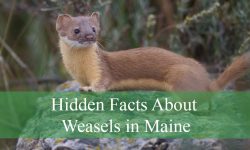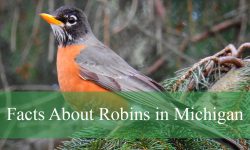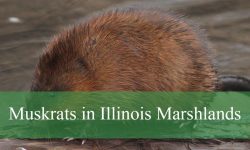Bugs That Look Like Ladybugs are diverse and fascinating, showcasing nature’s penchant for mimicry. These insects, spanning various species, share similarities with the beloved ladybug but possess unique characteristics.
From the Paraplectana spiders with their dome-shaped bodies to the Prosoplecta cockroaches mimicking different ladybug patterns, the resemblance is often striking.
Continue reading the article to learn more about 16 bugs that look like ladybugs and to explore their characteristics and behaviors.
Different Types of Bugs That Look Like Ladybugs
Golden Tortoise Beetle
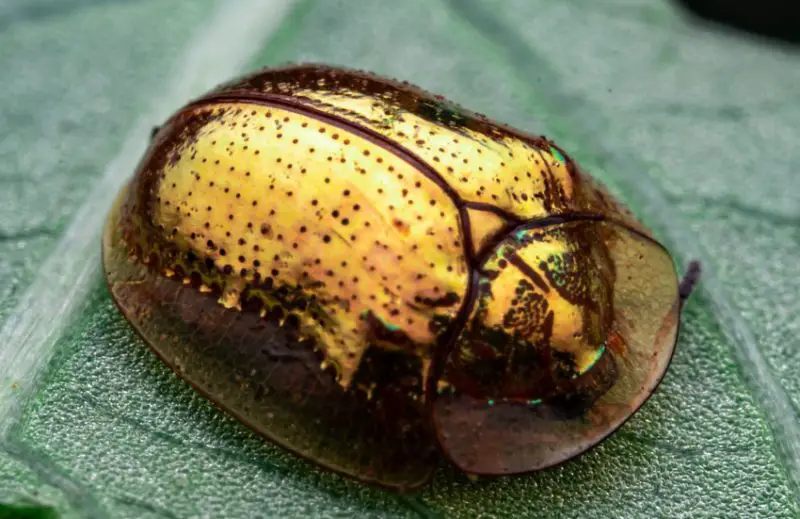
The Golden Tortoise Beetle (Charidotella sexpunctata) is a remarkable bug that shares size and shape similarities with ladybugs. Growing up to 7 mm, this dome-shaped beetle is primarily known for its lustrous golden exterior adorned with small black markings.
However, its most fascinating feature is its ability to change color. While typically golden, the beetle can shift to a red-brown hue during mating, when sensing danger, or upon hydration. This chameleon-like quality sets it apart from other similar-sized insects.
Argus Tortoise Beetle

The Argus Tortoise Beetle (Chelymorpha cassidea), native to the Caribbean, derives its name from the many-eyed Greek mythological figure Argus Panoptes. This bulbous beetle bears a striking resemblance to ladybugs in its body shape, size (up to 0.47 inches), and markings. Its dark yellow or yellow-red body, adorned with black spots, further enhances this similarity.
However, the Argus Tortoise Beetle possesses unique characteristics that set it apart. Most notably, it can extend its head outward in a manner reminiscent of turtles, a feature not found in ladybugs. This distinctive trait, combined with its habitat preferences, distinguishes it from its lookalike counterparts.
Mottled Tortoise Beetle

The Mottled Tortoise Beetle (Deloyala guttata), primarily inhabiting Central and North America, bears a partial resemblance to ladybugs. Its most distinctive feature is a shiny golden back adorned with stripe-like markings, setting it apart from typical ladybug patterns.
Unlike the dome-shaped bodies of ladybugs, this beetle possesses an irregular body shape that tapers from head to abdomen. The similarity to ladybugs is largely confined to its small head and the presence of markings on its back. These unique characteristics make the Mottled Tortoise Beetle an intriguing example of how insects can share certain features while maintaining their distinct identity.
Spotted Cucumber Beetle
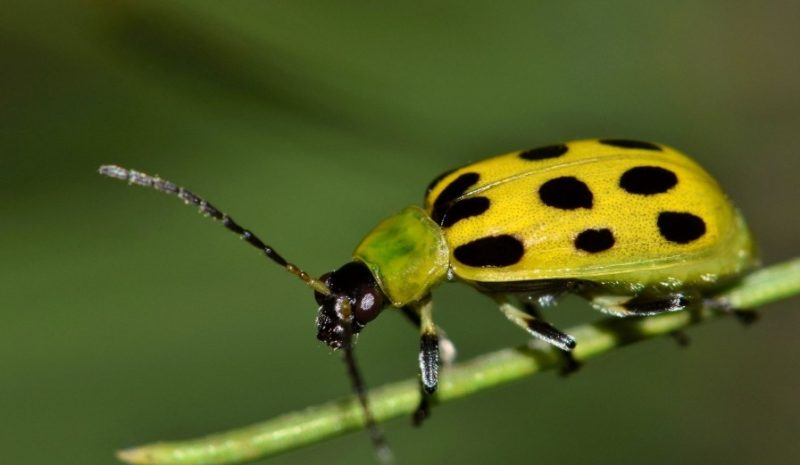
The Spotted Cucumber Beetle (Diabrotica undecimpunctata) is a common pest in cucumber and squash crops, laying eggs near its food source. This insect bears a striking resemblance to yellow ladybugs, featuring a yellow body adorned with black marks. Its small black head further enhances this similarity.
However, subtle differences distinguish it from ladybugs, primarily its slightly elongated body compared to the rounder shape of most ladybugs. Despite these minor variations, the Spotted Cucumber Beetle’s overall appearance can easily lead to misidentification.
Ladybird-Mimicking Spider
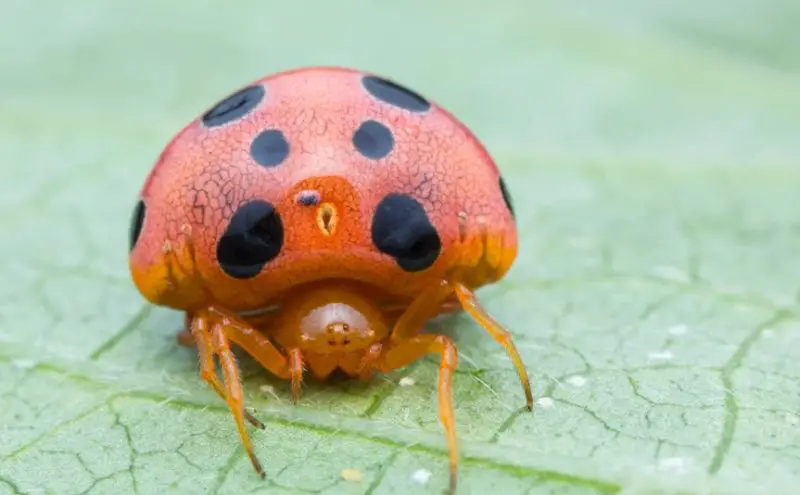
The Paraplectana genus of spiders, commonly found in Southern Africa, exhibits a remarkable resemblance to ladybugs. These arachnids possess a dome-shaped body reminiscent of both ladybugs and turtles, with their heads positioned lower than their bodies. Their orange-red or yellow-orange coloration, adorned with up to 11 black marks on the back, further enhances this mimicry.
However, keen observers can spot key differences. Unlike ladybugs, these spiders feature a vividly colored yellow-orange head devoid of black marks. Additionally, their legs match the body’s hue, contrasting with the typically black legs of ladybugs.
Beetle-Mimicking Cockroach
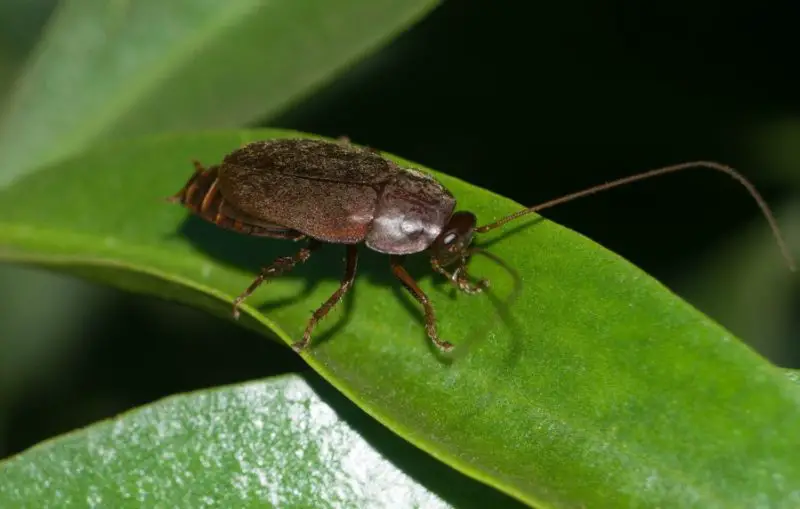
The Prosoplecta genus of cockroaches presents a fascinating case of mimicry, with 21 species resembling various ladybugs. Unlike typical brown or black cockroaches, these insects mimic the appearance of several ladybug species. Some Prosoplecta cockroaches bear a striking resemblance to Seven-spot ladybugs, featuring red bodies with black spots. Others mirror the yellow and black coloration of 22-spot ladybugs.
The Asian cockroach, a Prosoplecta species, closely resembles the bright orange Convergent Lady Beetle. Additionally, some Prosoplecta roaches exhibit pale orange bodies with black marks, similar to Nine-spotted lady beetles.
Swamp Milkweed Leaf Beetle
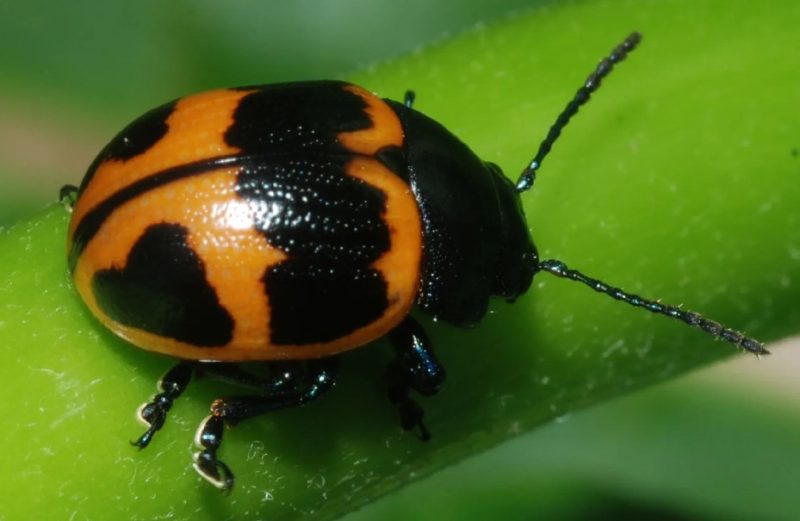
The Swamp Milkweed Leaf Beetle (Labidomera clivicollis) bears a remarkable resemblance to red ladybugs, featuring a similar dome-shaped body with red or orange coloration punctuated by black markings. However, a key distinguishing feature is the size of these black marks, which are notably larger on the Swamp Milkweed Leaf Beetle compared to those on ladybugs.
In terms of size, both insects share similarities, with both capable of growing up to 0.17 mm under favorable feeding conditions.
Larger Elm Leaf Beetle
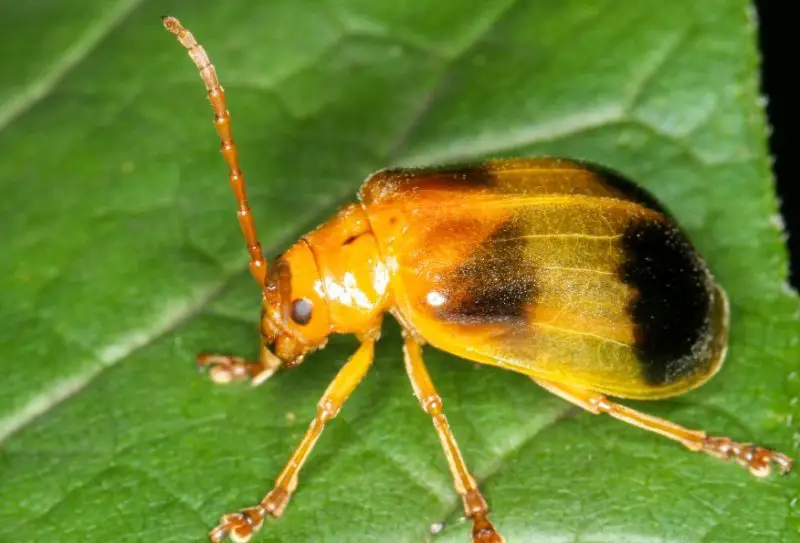
The Larger Elm Leaf Beetle (Monocesta coryli) is commonly found in forests and around pecan and birch trees. This insect bears a striking resemblance to yellow ladybugs, featuring a yellow-orange body adorned with four large dark spots. While its overall shape is similar to that of most ladybugs, the Larger Elm Leaf Beetle has a distinct pear-shaped profile rather than the typical dome shape.
Its body is characteristically wider towards the abdomen and narrows near the head. This unique body structure, combined with its coloration and habitat preferences, sets it apart from true ladybugs while maintaining a superficial similarity that could lead to misidentification.
Bean Leaf Beetle
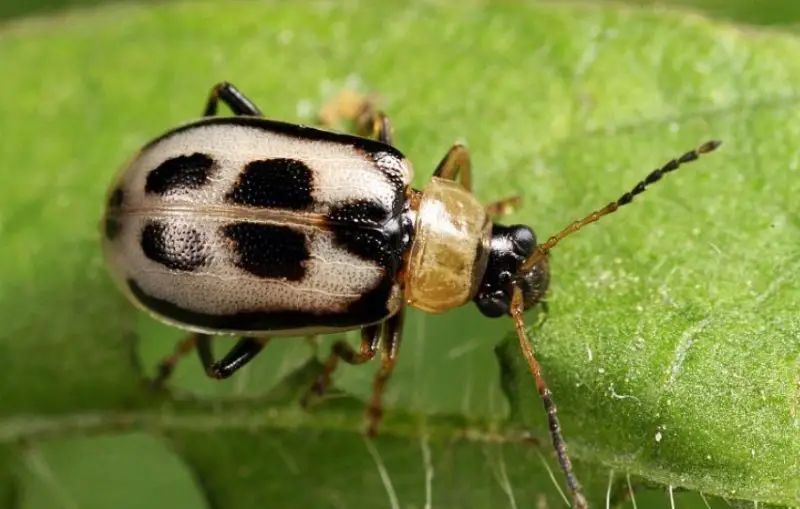
The Bean Leaf Beetle (Cerotoma trifurcata) is primarily found in alfalfa, bean, and soy crops, where its golden coloration stands out against green foliage. This insect bears a striking resemblance to many ladybug species, featuring a short, round body with distinctive markings.
Its golden exterior is adorned with four black spots on the back and black stripes running along the body’s margins. Like ladybugs, the Bean Leaf Beetle possesses a small black head, further enhancing the similarity.
Eight-Spotted Flea Beetle
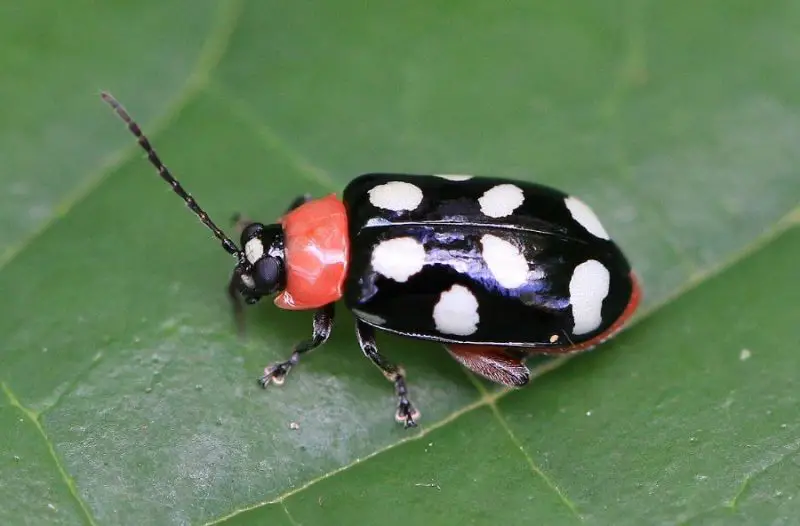
The Eight-spotted Flea Beetle (Omophoita cyanipennis) bears a resemblance to dark-colored ladybugs, but has distinct characteristics. Found in Texas and throughout Central and South America, this insect features a shiny black, elongated body adorned with eight large, irregularly sized white marks. Its small black head, similar to that of ladybugs, typically displays a single round white mark in the center. The beetle’s black and white antennae further distinguish it.
While sharing some similarities with ladybugs, such as the small head, the Eight-spotted Flea Beetle’s elongated body shape sets it apart from the typical dome-shaped ladybug silhouette, creating an intriguing example of partial mimicry.
Ladybird Bug

The Ladybird bug (Steganocerus multipunctatus), prevalent in sub-Saharan climates and cotton fields, bears a striking resemblance to classic ladybugs but has distinctive features. Its body sports an orange and black color scheme, mimicking the familiar red and black pattern of typical ladybugs.
Multiple orange markings adorn its black body, including two large orange spots on its black head. The insect’s antennae display a mix of black and orange coloration. While maintaining a dome-shaped profile, this beetle is notably wider and slightly flatter than conventional ladybugs.
Asian Lady Beetle
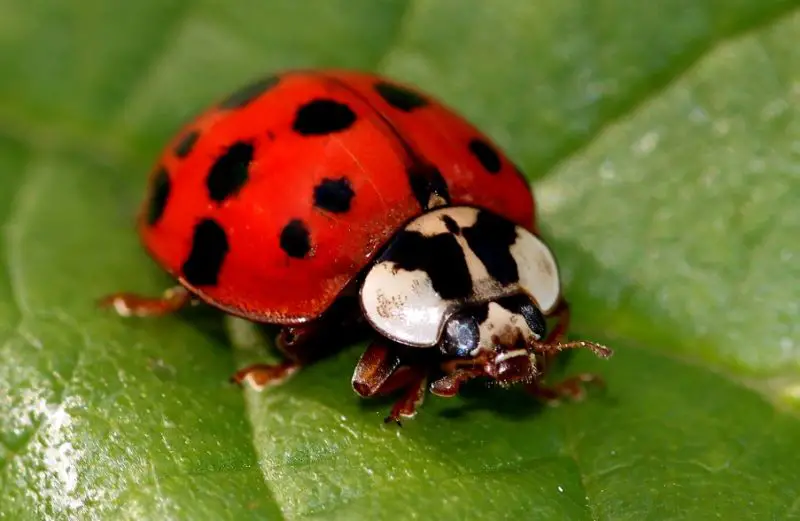
The Asian lady beetle closely resembles ladybugs with its red, round body and black markings, but several key differences set it apart. Its body is wider and flatter compared to the dome-shaped ladybug. Behaviorally, Asian lady beetles are house pests, seeking warmth indoors, and are known to bite, unlike true ladybugs.
The most distinctive feature is the head: while the common Seven-spot ladybug has a small, all-black head, the Asian lady beetle’s head is wider, longer, and features white markings on its black background. These differences in appearance, behavior, and habitat preferences help distinguish the Asian lady beetle from its more benign lookalike.
Grapevine Beetle
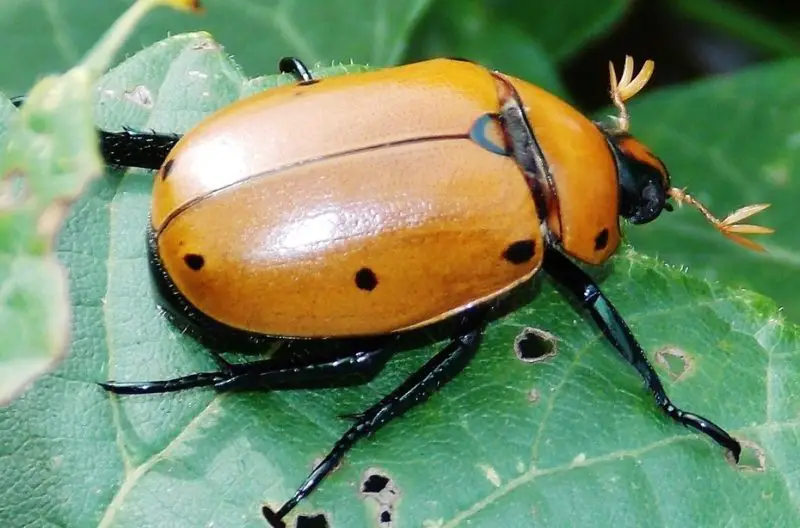
The Grapevine Beetle (Pelidnota punctata) presents a unique appearance that bears some resemblance to ladybugs. Its most distinctive feature is its off-yellow coloration, punctuated by four small black marks on its body. Thin black lines divide the elytra, adding to its visual complexity.
The beetle’s head, also off-yellow, is marked by a prominent black spot. In a characteristic shared with most ladybug species, the Grapevine Beetle possesses all-black legs.
False Ladybird
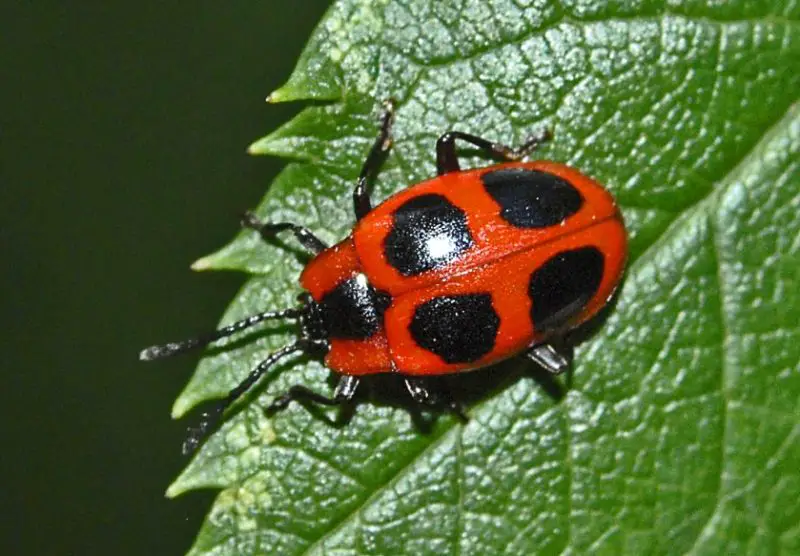
The False Ladybird (Endomychus coccineus) is aptly named for its remarkable resemblance to true ladybirds. However, key differences distinguish it from its namesake. Most notably, the False Ladybird has a flatter body compared to the dome-shaped profile of genuine ladybirds.
Its coloration features larger black markings, creating a more balanced dual-color appearance, unlike the predominantly red ladybirds with smaller black spots.
Distinctive red stripes run along its body, including one along the mid-section. Interestingly, False Ladybirds inhabit different ecosystems and have unique dietary preferences, primarily feeding on wood mushrooms from birch trees, further setting them apart from true ladybirds.


